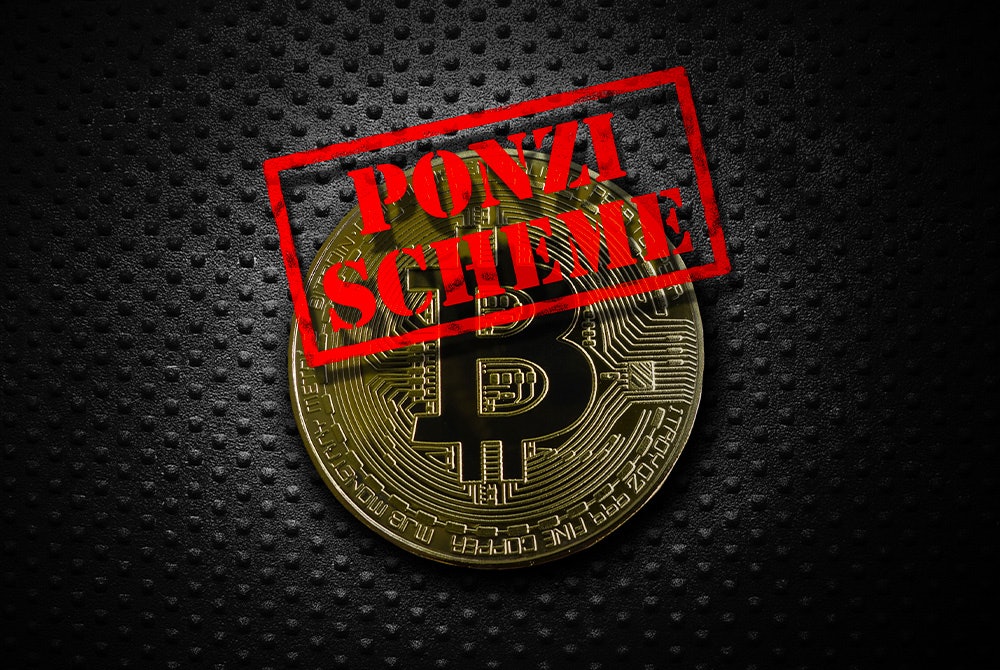- What Is a Bitcoin Ponzi Scheme?
- How To Beat Bitcoin Ponzi Schemes
- Red Flags of a Bitcoin Ponzi Scheme
- Fallen for a Bitcoin Ponzi Scheme?
- Frequently Asked Questions
Bitcoin and other cryptocurrencies have been steadily gaining popularity over the last decade. With the price of bitcoin well above where it started, it continues to be a lure for investors. However, scammers also understand bitcoin’s appeal, and they use it in bitcoin Ponzi schemes to defraud investors.
What Is a Bitcoin Ponzi Scheme?
A bitcoin Ponzi scheme is one in which scammers promise investors returns on a bitcoin investment, but the funds they get come from other investors instead of investment strategies. They may promise returns in fiat currencies or in the form of a token they claim to have minted on their blockchain.
How Does a Normal Ponzi Scheme Work?
With every Ponzi scheme, scammers promise high returns, and as a result, many investors flock to the scheme and deposit their money. However, instead of investing customers’ funds in legitimate investments, the Ponzi scammers take some of the capital invested and give it to the other investors. In this way, they can fake very high returns—at least for a while.
Eventually, the funds stop coming in, and because there’s no actual growth of the funds people have given the scammers, the returns dry up, and the scam is exposed.
Here’s how bitcoin Ponzi schemes work.
You See an Advertisement Promoting a Bitcoin Investment
These ads may pop up on your computer or device’s screen, or they may appear as banners on other websites. They may also appear in your social media feed or an email. In every case, the ad will promise high returns for investing in bitcoin. They will typically be significantly higher than what you could earn by investing in the S&P 500, which earns a rate of around 9.2% per year.
In some cases, bitcoin Ponzi schemes will promise high returns between 5% and 15 every month.
You’re Asked to Deposit Regular Money to Fund Your Investment
The scammers will ask you to deposit flat currency to get started. They will promise to either invest your money in bitcoin or a bitcoin-based fund and get you significant returns.
The Scammer Fakes Your Returns
As the scammers collect more and more money from investors, they give some to those who got in early. For example, if you invested $1,000, and the scammers promised 5% per month returns, they may take $50 (your “5% return”) from another investor’s funds and give it to you.
When they promise to give you returns in the form of their token, they may show you reports of the value of their token going up. However, there’s no blockchain supporting the token, so the valuations are fake.
The Returns Slow Down or Stop Coming in Altogether
Initially, because the hype around the investment garners so much interest, you keep getting great returns because your money is coming from other people’s funds. However, the incoming funds start slowing down because the initial blitz of interest slows down, or people begin to see the scam for what it is. Your investment then stops “earning returns” as high as it initially did.
You Try To Withdraw Your Funds but Can’t
When you try to withdraw your funds, the scammers will either put long delays in place or deny you access to your funds altogether. They may disappear and take your money with them, or they may pretend the fund took a hit and your money was lost due to natural market forces out of their control.
However, because your money was never actually invested in an investment vehicle, there are no returns to be collected. If you had been able to withdraw funds prior to the Ponzi scheme collapsing, those might be the only “returns” you get. Meanwhile, the scammers have disappeared with your money.
How To Beat Bitcoin Ponzi Schemes
To avoid getting wrapped up in a bitcoin Ponzi scheme, you should keep the following in mind:
- Never give your money to an unregistered investment company or one without a stellar reputation and a long, established history.
- Avoid bitcoin investments that promise steady returns.
- Avoid bitcoin investments that claim you can earn extremely high monthly or yearly percentages.
- Avoid any bitcoin investment that makes it sound like there is minimal risk of the investment underperforming.
- Thoroughly research the investment company and reach out to the SEC to verify its legitimacy.
Red Flags of a Bitcoin Ponzi Scheme
If you see any of these red flags, there’s a high chance someone is trying to run a bitcoin Ponzi scheme:
- High returns with little risk
- Consistent returns
- Difficulty receiving payments or withdrawing funds
High Returns With Very Little or No Risk
There is no such thing s a guaranteed investment. On the contrary, every investment carries a significant risk of loss, and anything promising otherwise is a scam.
Very Consistent Returns
Bitcoin goes up and down dramatically from week to week and sometimes from day to day. So if you see an investment portfolio showing fairly steady historical returns from one month to another, there’s a good chance it’s a scam.
Difficulty Receiving Payments
If it takes a long time to withdraw your funds or if they come up with excuses as to why you can’t get your money, they may be shifting your funds around to give them to other investors or simply putting your money straight into their pockets.
Bitcoin Ponzi Scheme Example
Bitcoin Savings and Trust (BTCST) was a bitcoin Ponzi scheme ran by Texan Trendon Shavers. He sold bitcoin investments online, raising more than $4.5 million worth of bitcoin in two years.
The U.S. Securities and Exchange Commission (SEC) alleged that Shavers promised his investors up to 7% interest each week, but in reality, he used new investor money to pay this interest and stole money for his own personal gain.
Shavers was charged by the SEC in 2013 for defrauding investors in his Ponzi scheme.
Fallen for a Bitcoin Ponzi Scheme?
If you’ve fallen for a bitcoin Ponzi scheme, you may be able to recoup some of your losses, but only after the authorities shut down the scammers. At that point, their funds may be frozen, and you can then use legal channels to retrieve some or all of your money back.
If the scammers haven’t been able to pocket your money and leave with it, and it is still inside an account, authorities may be able to liquidate that account, and you can get some or all of your money back in the liquidation process.
Report the Scam
You should act quickly once you realize you’ve fallen victim to a bitcoin Ponzi scheme. Contact the:
- U.S. Securities and Exchange Commission (SEC)
- Financial Industry Regulatory Authority (FINRA)
- North American Securities Administrators Association (NASAA)
- Local authorities
Although reporting the scheme may not help you get all of your money back, it will make sure the scammers are shut down and may help you recoup your losses.
Be sure to document every communication with the scammers, including when you spoke with them on the phone, through text, or email, as well as any written communications they sent you.


Comments